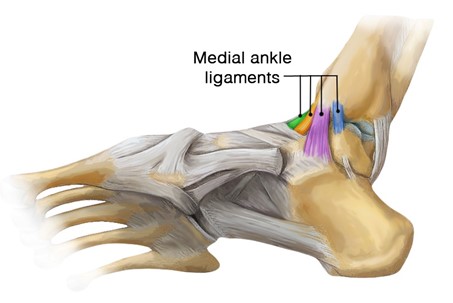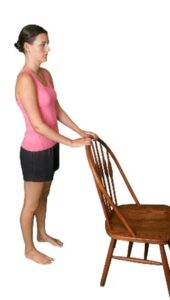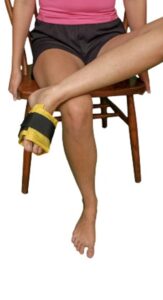How to Treat Inner Ankle Pain with Exercise (and When to Go to a Pain Professional)
October 17, 2025

Chronic ankle pain is very common. Inner ankle sprains typically occur in athletic individuals, those who dance, and the elderly. If it’s very severe, the ankle swells, but if it’s not so severe, it can just be painful for a very long time. Today, I’ll discuss how to assess and treat inner ankle pain through exercise (and when to consult a pain professional).
What are Ligaments in the Inner Ankle?
Ligaments are strong cords that hold bones together. The foot has over a hundred of them. The bottom of the shinbone and the foot join to form the inner ankle. Four main ligaments hold this area together. They help keep your arch from falling toward the floor, but as these ligaments stretch over time, you become more vulnerable to injury.
Why Does Swelling Happen in the Inner Ankle?
One way you know that a ligament is involved in an injury is that there is swelling in the joint. When muscles or tendons (that attach muscles to bones) are injured, there is no swelling. When you sprain your ankle severely, the ankle swells in an attempt to stop you from hurting yourself more. There is frequently no visible swelling if it’s just a mild sprain.
When Should I Go to a Pain Professional for My Inner Ankle Injury?
When you have a swollen, painful ankle, the first thing to do is see a physician for an X-ray to make sure it’s not broken. If you have a mild sprain with minimal pain that lasts more than a week, always seek out a therapist who specializes in the assessment and treatment of pain. You want the sprain to heal with aligned scar tissue, and a skilled therapist can help you heal more quickly, without scar tissue adhesions. A massage therapist with specialized injury training can often help your ankle heal more effectively.
How Would a Pain Professional Assess an Inner Ankle Injury?

A physician or therapist specializing in pain and injury will flex your foot and rotate it to reproduce the pain of an inner sprained ankle. If finger pressure is painful when applied around the underside of your ankle bone, you likely have sprained your inner ankle.
How Would a Ligament Injury to the Inner Ankle Be Treated?

Sometimes, the ligaments heal, and the pain disappears. But more often, the pain lingers for a long, long time. When there is unresolved adhesive scar tissue, low-level pain either continues or there is a vulnerability to reinjure the ankle over and over again.
For self-healing or treatment to be successful, all of the poorly formed scar tissue must be resolved. This can be accomplished with either hands-on therapy or injection therapy. But for healing to be sustainable, rehabilitation exercises should accompany either treatment.
What Rehabilitation Exercises Should I Do While Being Treated?
When the ankle is sprained, and you don’t walk normally, all of the lower leg and foot muscles begin to weaken. This is called muscle atrophy. Therefore, exercise therapy is essential.
Move the foot in multiple directions, but only as far as you can without pain. Hold your foot in the air and move it side to side, forward, and back. Then, try doing a series of circles in both directions. Do this as frequently as possible throughout the day, provided you can do so without experiencing pain or discomfort. This prevents the formation of adhesive scar tissue and allows your ligaments to heal properly.
What Rehabilitation Exercises Should I Do When I’m No Longer in Pain?
Even when you have no pain, you must still strengthen the muscles in the four quadrants of the lower leg as well as your ankle ligaments. There are muscles in the front of your lower leg, which are usually referred to as the shin muscles. Then, you have the calf muscles in the back. These are easy for you to identify.
But you also have muscles that move your foot from side to side. The ones on the outside are clear, but the ones that move your foot inward are underneath your shinbone and out of sight.
You want to be sure to exercise all of these muscles in your leg and ankle to return stability to your lower leg and foot.




The heel raises exercise is a good place to start. The one I recommend is the Outer and Inner Sprained Ankle exercises. Make sure to watch the introduction video first because it goes over the typical exercise regimen I have my clients do.
If you are experiencing pain and live in the Boston area, schedule an appointment or a complimentary 10-15 minute phone consultation.
Schedule an Appointment or Call →
Ben E. Benjamin holds a Ph.D. in Sports Medicine and was the founder and President of the Muscular Therapy Institute in Cambridge, Massachusetts. He is the author of dozens of articles on working with injuries and chronic pain as well as the widely used books in the field, Are You Tense? Exercise Without Injury and Listen To Your Pain: The Active Person’s Guide to Understanding, Identifying and Treating Pain and Injury. Dr. Benjamin has been in private practice for over 50 years and teaches therapists throughout the country.
How to Treat Inner Ankle Pain with Exercise (and When to Go to a Pain Professional) FAQs
- What are ligaments in the inner ankle?
Ligaments are strong cords that hold bones together. The inner ankle has four ligaments.
- Why does swelling happen in the inner ankle?
This means that a ligament is involved in an injury, and swelling helps prevent you from hurting yourself more.
- When should I go to a pain professional for my inner ankle injury?
When you are first injured and have a swollen, painful ankle, visit a physician for an x-ray. If the pain is mild and lasts more than a week, seek out a massage therapist specializing in friction therapy for pain and injury.
- How would a pain professional assess an inner ankle injury?
They will flex your foot and rotate it, as well as apply finger pressure to multiple ligaments, in order to see where the injury is located.
- How would a ligament injury to the inner ankle be treated?
Sometimes, it goes away on its own. But often, the ankle will need to be treated through hands-on therapy or injection therapy.
- What rehabilitation exercises should I do while being treated?
Move the foot in multiple directions, but only as far as you can without pain. Hold your foot in the air and move it side to side, forward, and back. Then, try doing a series of circles in both directions. Do this as frequently as possible throughout the day, provided you can do so without experiencing pain or discomfort.
- What rehabilitation exercises should I do when I’m no longer in pain?
The heel raises exercise is a good place to start. The one I recommend is the Outer and Inner Sprained Ankle exercises. Make sure to watch the introduction video first because it goes over the typical exercise regimen I have my clients do.
Related Posts

Why Does My Old Injury Still Hurt?
Question: What is the common denominator of chronic pain?
Answer: ADHESIVE SCAR TISSUE

Can Massage Help Pain that Travels? Cambridge MA
Question: Why does an injury to the neck cause pain that travels to the arm and hand? Answer: Referred Pain Pain that travels in your body is called Referred Pain. This phenomenon means the injury is in one place, and the pain is in another. Understanding this phenomenon helps you better understand your body’s responses […]

Can Massage Therapy Help Lower Back Pain Cambridge, MA?
Lower back pain is experienced by at least 50 million people each year in the United States alone. My own severe back pain when I was a teenager is what led me into this field. Back pain is often a debilitating, terrible experience. But it can also be annoying and limiting. I’ve treated hundreds of […]

Massage Therapy for Chronic Neck Pain Near Cambridge, MA
Question: What’s the most common cause of chronic neck pain? Answer: Ligament sprains The Causes of Pain in Your Neck For many reasons, your neck can be painful, but most people are unaware of the most common cause of chronic neck pain. Sprained or severely injured muscles can cause pain in the neck, but muscles […]

Can a Massage Therapist Fix a Frozen Shoulder in Cambridge, MA
Question: Does a frozen shoulder always go away with time? Answer: Often no. The Causes of Frozen Shoulder A frozen shoulder can be incredibly painful. The pain originates in the shoulder joint. A joint is formed where any two bones meet. It’s the enclosed space between your upper arm bone, the humerus, which is […]
